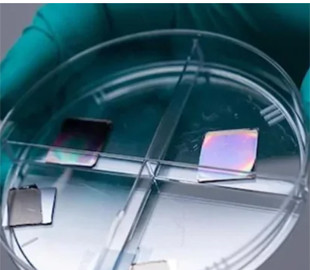
In TES systems, a thermal emitter captures heat and converts it into electromagnetic radiation, which is then used by a photovoltaic cell to generate electricity.
Researchers at Rice University have developed a highly efficient thermal emitter that could help develop practical and scalable TES systems. It heats up and converts the heat into electromagnetic radiation, which is then captured by a photovoltaic cell to generate electricity, interestingengineering.com reports.
Batteries are not perfect: they are made from rare minerals, the extraction of which provokes CO2 emissions; they also release harmful chemicals into the environment and have a limited service life. When it comes to energy storage, scientists are looking for a more environmentally friendly and cleaner solution than batteries. One such promising direction is thermal energy storage (TES), which stores electricity by converting it into heat, which can later be converted back into electricity.
TES require inexpensive materials, have a much longer lifespan than batteries, and are easier to scale across systems. They can stabilize renewable energy grids by storing additional solar or wind power when it is available and delivering it during peak demand. TES designs often use a thermophotovoltaic (TPV) system to convert heat into electricity.
TES include two main components — photovoltaic (PV) cells, which convert light into electricity, and thermal emitters, which convert heat into light. Both of these components must work well for the system to be efficient.
Until now, scientists have mostly focused on improving the technology of PV cells. However, the main obstacle in the implementation of practical TPV systems is the energy losses during the conversion. This is where heat emitters come into play, a technology that has received comparatively less attention.
200% Deposit Bonus up to €3,000 180% First Deposit Bonus up to $20,000An efficient heat emitter is critical to minimizing energy loss when converting it from heat to electricity. Unfortunately, traditional TPV designs have not yet been able to include such a device.
Using traditional design approaches limits the design space for thermal emitters, and ultimately scientists end up with one of two scenarios: practical, low-performance devices or high-performance emitters that are difficult to integrate into real-world applications.
Researchers at Rice University have attempted to solve the problem. They have placed numerous silicon nanocylinders on a sheet of tungsten metal to make a thermal detector. When this system receives heat, photons are released. Meanwhile, the nanocylinders act as resonators, designed to absorb certain wavelengths, or energies, of these photons. They interact with each other in a way that allows them to selectively select and release only photons with the right energy. These photons are then sent to photovoltaic (PV) cells, where they can be converted into electricity.
This selective emission, achieved through knowledge of quantum physics, maximizes energy conversion and provides higher efficiency than previously possible.
Using quantum effects, the resonators are able to control the photons emitted at the quantum level, ensuring that only the most useful photons for the photovoltaic (PV) cell are emitted, which increases the overall efficiency of the system.
The resulting quantum thermal emitter showed an impressive efficiency of 60%, and the researchers say they can improve it even further using the new material.
“If our approach can lead to an efficiency increase from 2% to 5% in such systems, it would be a significant boost for missions that rely on efficient power generation in extreme conditions,” they explained.

